America Obscura (3)
By:
November 13, 2016
HILOBROW friend Andrew Hultkrans is a legendary freelance journalist; we have admired his range, erudition, and virtuosity since the early ’90s, when he was a columnist at MONDO 2000. We’re proud to publish this series of essays by Andrew, each of which originally appeared (as noted) elsewhere.
Buckwild Kingdom: Nature Revenge Porn
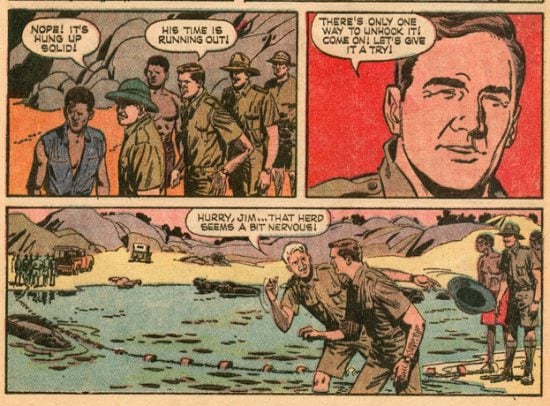
Adult children of the ’70s will recall this scenario, nestled deep in their cathode-ray consciousness: “We’ll watch Jim from the safety of this customized titanium Sherman tank as he attempts to subdue a giant anaconda while taking saliva samples from the snapping jaws of an enraged leopard.” Yes, every week the avuncular, McLuhanesque Marlin Perkins would take us and his beleaguered, maul-scarred assistant Jim into the maws of wild predators, while he remained ensconced in a heavily armored vehicle or aircraft. The “White Hunter-on-safari” approach pioneered by Perkins and his show Mutual of Omaha’s Wild Kingdom remained the template for nature documentaries until recently. (That the show was sponsored by an insurance agency was the program’s most delicious irony, casting Marlin and Jim in a barely concealed salesman-policy-holder relationship.) Today, an idling channel-surfer might stumble onto a nature show after a bong hit or two, expecting the benevolent mastery of Perkins or someone like him, and instead be confronted by an alarming conflation of Wild Kingdom, Cops, and Faces of Death. The immense popularity of “reality-based” television has spawned a new breed of nature programs—snuff videos for animal lovers, really—which unflinchingly capture violent animal attacks on human beings.
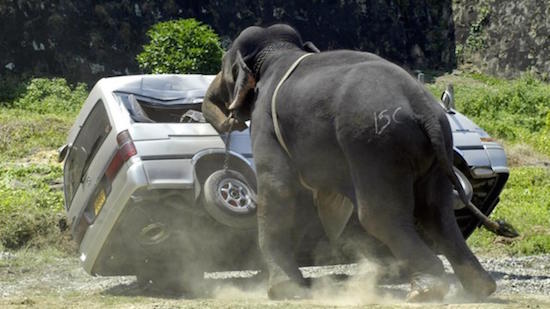
Filmed in the flat, high-key style of cheap video porn and the “Jerky-Cam” method of the amateur camcorder owner, these animal attack programs function both as voyeuristic exploitation films and as projections of the masochistic fantasies of late 20th-century America. On the surface, the shows offer the same vicarious thrill of “reality” programs like Cops, where from the safety of a barcalounger one can witness intoxicated felons going buckwild while paramilitary police officers employ excessive force and dime-store psychology. One of the subtexts of Cops is the unacknowledged satisfaction viewers feel while observing societal discipline in action. Even self-proclaimed liberals derive a certain sense of relief from seeing a violent, frothing criminal tasered, cuffed, and shoved into the back of a van. Cops also speaks to our subconscious desire, exhaustively explored by Michel Foucault, to be disciplined and punished ourselves (since we are raised under the auspices of control, we perpetuate and desire such control as adults). Animal attack shows like Fox’s When Animals Attack and CBS’s The World’s Most Dangerous Animals up the ante on this subconscious need for discipline by adding masochistic guilt fantasies about the revenge of nature. In a peculiar manifestation of “the return of the repressed,” animal snuff TV represents humanity’s collective guilt for centuries of conquering nature and destroying the environment through hunting, development, and industry. As animals have become the underdog, so to speak, in a war against extinction, something in our collective conscience wants to see them strike back against their mortal enemy—us.
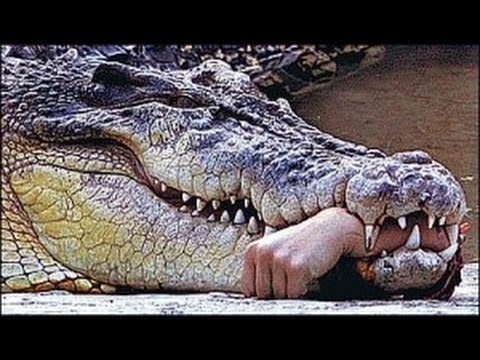
A quick glance at the PR materials promoting these shows, from such reputable media organs as National Geographic, The Discovery Channel, and Time/Life, neatly reveals this masochistic subtext: “Almost extinct 20 years ago, these fierce reptiles (Australian saltwater crocodiles) are back with a vengeance—and they’re not shy any more. They attack boats, ambush swimmers, drown scuba divers, and seize fisherman…the one that gets you is the one you never see!” (Crocodile’s Revenge); “Today about 2700 of these larger cousins of the well-known grizzly [Kodiak bears] still thrive there [on Kodiak Island]. But change looms on the horizon. Portions of the island are open to development. Dramatic home videos of dangerous tourist/bear encounters capture the uneasy clashes of Kodiak’s modern and natural worlds.” (Giant Bears of Kodiak Island); “This National Geographic Special takes viewers on a journey to Churchill, Manitoba, where the residents have learned to live with a unique wildlife problem. Each fall the largest, most deadly carnivore in the Arctic migrates though this isolated Canadian village on an annual northward trek… For residents, it is a season of apprehension.” (Polar Bear Alert). The titles alone of other shows further reinforce this perverse combination of anxiety and titillation: The Snake that Ate Guam!; Meanest Animal Alive; Beautiful Killers; Crocodiles: Here Be Dragons; Man Eaters of India.
If the promotional discourse surrounding this cycle of shows hints at the repressed urge to see the wild kingdom stage violent revolution against its tyrannical monarch, the content of the programs makes it explicit. Among the sundry shark attacks, crocodile ambushes, and “uneasy clashes” between humans and animals in the wild, the standout sequences in these shows involve animals under some form of human subjugation: animals in crowded tourist parks, animals in zoos, and trained performing animals. By coincidence, it seems, most of these attacks involve bears, belying their cuddly image as children’s doll/benevolent protector against forest fires. In one hilarious sequence, a trained circus bear is sitting in a chair next to a television host in a Polish TV studio, its trainer standing in the background. The trio are readying themselves for some kind of talk show, when without warning, the previously well-mannered bear leans over and swiftly mauls the talk show host as the trainer desperately beats it on the back. The sequence is replayed in slow-motion for maximum voyeuristic detail. Another scene shows a sprinting grizzly ramming into the side of a tourist station wagon at what must be thirty miles per hour. The car rocks with the impact, the moans inside are audible. A third sequence involves a polar bear at a zoo furiously grabbing a Chinese man who has climbed over the safety fence for a photo op in front of the bear. The man is pulled tight against the bars of the cage as the polar bear tears at his clothing, his friends vainly attempting to remove the jacket which binds him to the cage. Not only are these scenes some of most startling, they are also the most satisfying, and often, the funniest. There is something unintentionally comical about the 0-to-60 escalation from safe, tourist banality to violent, life-or-death mayhem. One feels that the intrepid wilderness explorers are knowingly putting themselves at risk, and that their animal attacks are an occupational hazard. But the evisceration of an unwitting tourist or zoo-goer seems unprecedented, transgressive, and in a sense, long overdue.
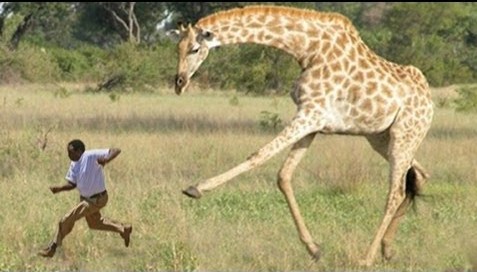
As engines of punishment, wild animals can be wonderfully effective and eminently watchable, yet their vigilante sprees are limited by the number of humans they can off per attack. Not so natural disasters—tornadoes, earthquakes, hurricanes, tidal waves—which can rub out an entire city in one swift, vengeful raid. Raising the stakes on violent animal porn and resonating nicely with millennial fears of plagues and disasters, National Geographic recently issued a series of weather porn videos—Nature’s Fury!, Cyclone!, and Volcano!—which amplify “the return of the repressed” to God-like proportions. Aside from abusing the exclamation point, these videos bring the Apocalypse into your living room, raising the specter of the Great Tribulation and Judgment Day in an era when doom-saying millenarian cults are without exception regarded as utter loons. The liner notes on the video boxes emphasize the cataclysmic scale of natural disasters: “Anyone, at any time, can fall victim to nature’s raging furies. Around the globe, hurricanes, tornadoes, and typhoons strike—without mercy and often without warning. So far this century, more than half a million lives have been lost to the violent forces of cyclones, tropical storms, and the wicked weather swirling in and around them. National Geographic chronicles some of the world’s most shocking storms with gripping footage and scenes of heart-thumping, real-life drama: roofs ripped from houses, trees snapped like toothpicks, and trucks tossed about like children’s toys… the forces of nature are among the most powerful forces on earth.”
Such purple prose is intended to titillate the potential buyer, obviously, but it also speaks to our unspoken desire to be punished on a global scale for our crimes against nature. The heroic human interest aspect of weather porn is more prominent than in its animal counterparts, but it does little to mitigate the perverse fascination with human annihilation: “You’ll meet heroes, fighting to save homes and lives, but see victims too, suffering unspeakable tragedies” (emphasis mine). The final clause of this sentence, pure frosting, recalls nothing more than the meaningless come-on rhetoric of porn video covers. It’s not surprising that National Geographic is trafficking in something analogous to pornography; after all, its magazine remains the only source of totally nude female photos you’re likely to receive from your grandmother. Nevertheless, the Society’s apparent willingness to sandblast any remaining patina of respectability off of its image by descending into the realm of psychotronic exploitation video just may be a sign of the Apocalypse.
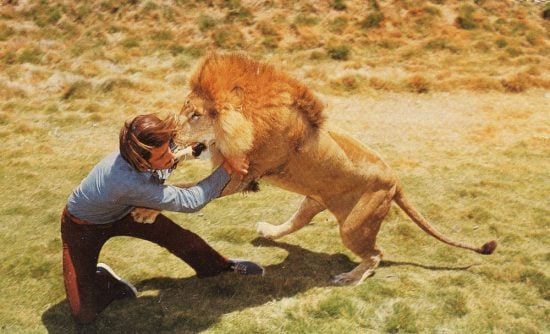
If Marlin Perkins were producing Wild Kingdom today, the unintentionally amusing subplot of regularly putting faithful assistant Jim in peril in order to get the close-up would be focus of the entire show. Indeed, given the bloody, pro-animal bent of contemporary animal porn, hyenas would be picking their teeth with Jim’s ribcage in under an hour. An army of willing sacrifices would have to be provided to High Priest Marlin in order to perpetuate the series, and public interest. When the ritual sacrifice of assistants no longer satisfied our masochistic guilt, the network would arrange (during sweeps week, of course) for Marlin’s augmented HumVee to be swallowed into the earth’s roiling core as a 7.8 earthquake opens a yawning chasm beneath him, signifying the end of the nature show as we know it.
Originally published by the web magazine STIM, August 1996.
CURATED SERIES at HILOBROW: UNBORED CANON by Josh Glenn | CARPE PHALLUM by Patrick Cates | MS. K by Heather Kasunick | HERE BE MONSTERS by Mister Reusch | DOWNTOWNE by Bradley Peterson | #FX by Michael Lewy | PINNED PANELS by Zack Smith | TANK UP by Tony Leone | OUTBOUND TO MONTEVIDEO by Mimi Lipson | TAKING LIBERTIES by Douglas Wolk | STERANKOISMS by Douglas Wolk | MARVEL vs. MUSEUM by Douglas Wolk | NEVER BEGIN TO SING by Damon Krukowski | WTC WTF by Douglas Wolk | COOLING OFF THE COMMOTION by Chenjerai Kumanyika | THAT’S GREAT MARVEL by Douglas Wolk | LAWS OF THE UNIVERSE by Chris Spurgeon | IMAGINARY FRIENDS by Alexandra Molotkow | UNFLOWN by Jacob Covey | ADEQUATED by Franklin Bruno | QUALITY JOE by Joe Alterio | CHICKEN LIT by Lisa Jane Persky | PINAKOTHEK by Luc Sante | ALL MY STARS by Joanne McNeil | BIGFOOT ISLAND by Michael Lewy | NOT OF THIS EARTH by Michael Lewy | ANIMAL MAGNETISM by Colin Dickey | KEEPERS by Steph Burt | AMERICA OBSCURA by Andrew Hultkrans | HEATHCLIFF, FOR WHY? by Brandi Brown | DAILY DRUMPF by Rick Pinchera | BEDROOM AIRPORT by “Parson Edwards” | INTO THE VOID by Charlie Jane Anders | WE REABSORB & ENLIVEN by Matthew Battles | BRAINIAC by Joshua Glenn | COMICALLY VINTAGE by Comically Vintage | BLDGBLOG by Geoff Manaugh | WINDS OF MAGIC by James Parker | MUSEUM OF FEMORIBILIA by Lynn Peril | ROBOTS + MONSTERS by Joe Alterio | MONSTOBER by Rick Pinchera | POP WITH A SHOTGUN by Devin McKinney | FEEDBACK by Joshua Glenn | 4CP FTW by John Hilgart | ANNOTATED GIF by Kerry Callen | FANCHILD by Adam McGovern | BOOKFUTURISM by James Bridle | NOMADBROW by Erik Davis | SCREEN TIME by Jacob Mikanowski | FALSE MACHINE by Patrick Stuart | 12 DAYS OF SIGNIFICANCE | 12 MORE DAYS OF SIGNIFICANCE | 12 DAYS OF SIGNIFICANCE (AGAIN) | ANOTHER 12 DAYS OF SIGNIFICANCE | UNBORED MANIFESTO by Joshua Glenn and Elizabeth Foy Larsen | H IS FOR HOBO by Joshua Glenn | 4CP FRIDAY by guest curators
